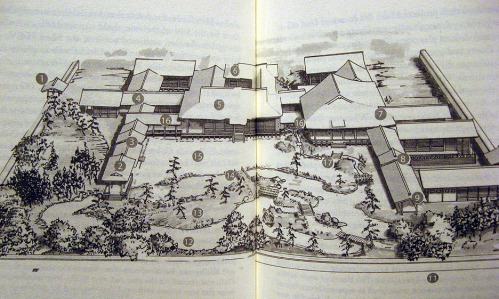Always fun to plumb historical texts for modern-day relevance or just plain curiosity, but it’s not so common to have something this old to read.
The Sakuteiki is a text from the Heian period and is a guide to designing a garden. The taboos are particularly entertaining, underlined with the warning, ‘To make a garden by studying nature exclusively, without any knowledge of various taboos, is reckless.’ There are problems with building it a certain way that would block the passage of the White Tiger, for example. A bit of texture, perhaps, but not very illuminating for those who grow plants today. More interesting is that they used grasses and flowering perennials more often than is now seen in modern Japanese gardens.
Kyoto stands on the site of the ancient Heian city, so there are layers of history here that go back a long way. The Heian city was master planned on a grid, like the Chinese Tang capital of AD 700. One of the most arresting images of the book I have, published in 2008 by Jiro Takei and Marc Keane, is of a Heian period residence of a regent family:
The organic relationship between the rectilinear house and the fluid garden is remarkable; it reminded me of a rectangular pot and a flowing tree rising from it. Residences of this type was carefully designed to afford many views of the garden. They were integrated in a sophisticated way that suggests a central relationship with nature. Granted, these were the residences of government officials and not the bunkhouses of Joe Schmo, but still…
Not sure there is any clear link here to what we do with bonsai. One thing is noteworthy, though: Like the eastern United States in the early settlement days, the old woods around the Heian city were demolished to support the growth of the city. There was nothing that was ‘wild nature’ for a great distance. Organically planned gardens re-created the feeling of nature inside the walls of their residences. I wonder if that is not a rare urge for those who live on city grids, and perhaps there is the link to our attraction to bonsai. It’s just remarkable how clearly the Japanese elite expressed that yearning in their lives. There are a lot of examples around the world of gardens designed around homes, but not many where the house is designed around the garden. I’d take my beret off to anyone who designs a house while thinking of a garden.

0 comments:
Post a Comment